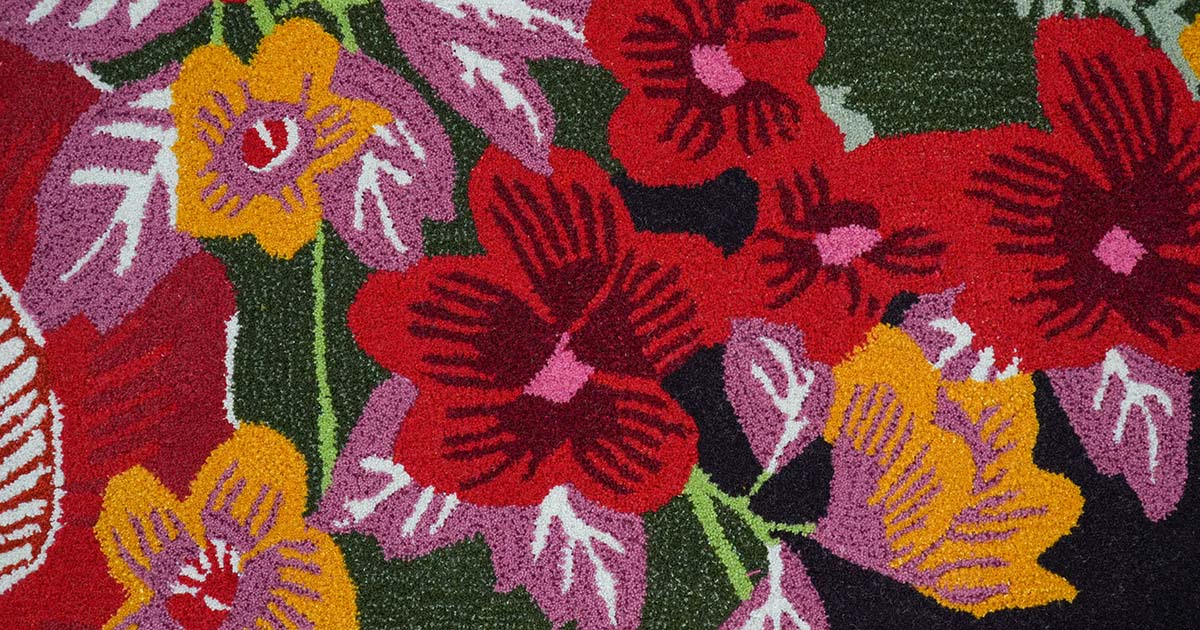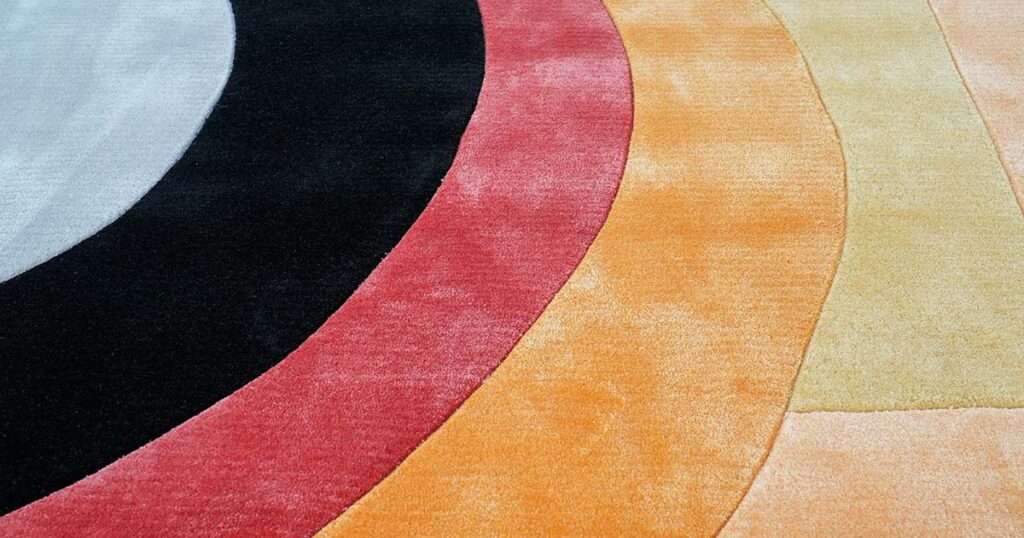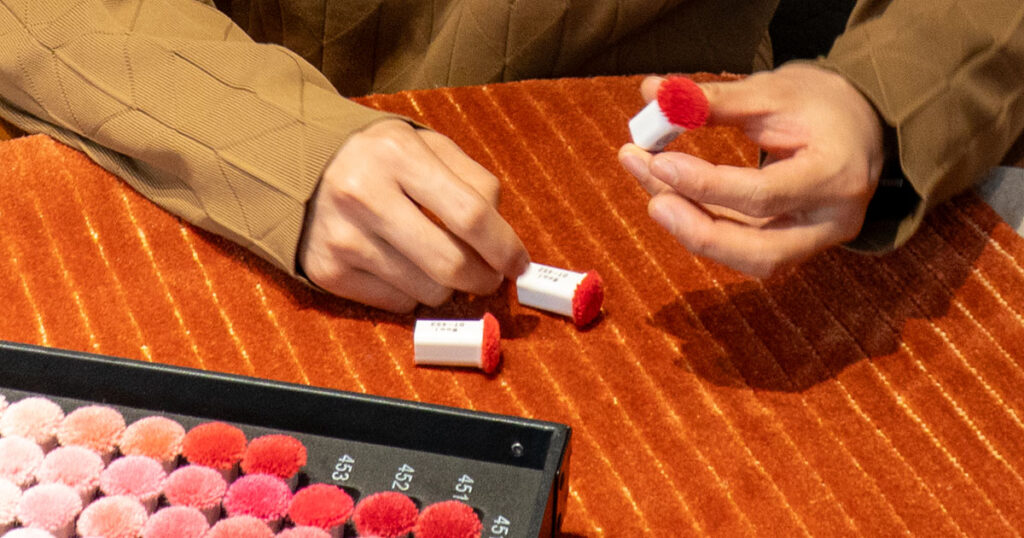In today’s interior design landscape, the connection between indoor spaces and nature has become increasingly important.
Tufted rugs with nature-inspired themes serve as the perfect bridge, bringing elements of the natural world into our commercial and residential environments.
These versatile floor coverings not only enhance aesthetics but also contribute to wellness by creating spaces that feel more connected to the natural world.
Nature-inspired tufted rugs range from literal depictions—like oversized tropical leaves and garden blossoms—to abstract interpretations that evoke natural elements through color, texture, and pattern.
This biophilic approach to design satisfies our innate affinity for nature while providing practical, beautiful floor coverings that define and enhance spaces.
What Are Tufted Rugs?
Before diving into design trends, let’s understand the basics of tufted rugs:
Tufted rugs are created by punching yarn through a backing material to create the pile (the surface you walk on). This can be done by hand with a tufting gun or by machine for mass production.
There are two main types:
Hand-tufted rugs: Created by skilled artisans using a handheld tufting gun, offering flexibility in design, pile height, and detail. Ideal for custom nature motifs with varied textures.
Machine-tufted rugs: Mass-produced using automated equipment, allowing for complex patterns at scale. Modern technology enables sophisticated natural patterns and organic visuals.
Both methods can incorporate cut and loop pile techniques to add texture and depth, creating dimensional effects that mimic natural elements like leaves, petals, or terrain.
Nature Themes Across Regions
North America: Biophilic Comfort
North American nature-inspired rug designs emphasize both calm and exuberance. Recent years have seen a surge in designs that create “a sense of serenity and refuge” through natural elements.
Popular motifs include:
- Bold tropical leaf prints and palm frond patterns
- Vivid floral arrangements
- Abstract organic shapes inspired by nature
- Traditional Persian-style rugs with intricate floral and vine motifs
Color palettes range from calming earth tones (sage greens, soft browns, sky blues) to vibrant nature-derived hues (jungle greens, ocean blues, floral pinks).
By 2025, moss and olive greens along with warm terracottas have become especially popular for their grounding effects.
American consumers tend to appreciate versatility in these rugs—some treating them as fashion accessories to update seasonally, others investing in timeless natural motifs that won’t go out of style.
Europe: Artistic Tradition Meets Modern Minimalism
European rug design shows a distinctive balance between heritage and modernity when incorporating nature themes. The region has embraced “earthy interiors” and natural materials, reflecting a desire for authenticity and tranquility.
Key European trends include:
- Sophisticated botanical designs with an artistic touch
- Abstract interpretations of landscapes and natural textures
- Revitalized classic floral patterns with modern colors
- Subtle tone-on-tone nature motifs for understated elegance
Color choices tend toward restraint—lots of neutrals, beiges, taupes, dusty roses, sages, and slate grays inspired by natural elements. Even when using bold colors, European designs typically maintain an artistic balance that integrates with the overall room aesthetic.
European consumers value rugs with a story or pedigree and often prefer those with sustainable credentials and authentic natural materials.
Middle East: From Paradise Gardens to Desert Modernism
The Middle East’s approach to nature-themed rugs reflects its rich textile heritage while embracing contemporary design elements.
Traditional “garden carpet” designs that portray paradise from a bird’s-eye view remain influential, featuring formal gardens with flowers, trees, and sometimes birds or animals.
Notable Middle Eastern trends include:
- Elaborate floral medallions and vine motifs
- Contemporary interpretations of traditional garden designs
- Desert-inspired patterns featuring dune shapes and palm motifs
- Rich, vibrant color palettes with increasing use of earth tones
Materials in Middle Eastern rugs traditionally center on wool and silk for luxurious texture and visual impact. The region typically favors large statement rugs that create dramatic focal points in both residential and commercial spaces.
Middle Eastern consumers often view rugs as symbols of hospitality, status, and cultural continuity—appreciating both traditional patterns and bold contemporary designs that showcase luxury and uniqueness.
Creating Memorable Spaces
Hospitality Sector
Hotels and resorts worldwide use nature-inspired tufted rugs to craft memorable, immersive environments. These rugs help guests feel connected to natural surroundings and enhance the overall experience.
In North America, hospitality carpets often feature abstract wave patterns, coral motifs, or forest-inspired designs that reflect local landscapes.
European hotels might incorporate botanical carpet designs that highlight local flora or create thematic environments—like Stockholm’s Downtown Camper Hotel with its “urban nature theme” and corridor carpets resembling forest trails.
Middle Eastern luxury hotels frequently showcase lavish floral patterns and botanical designs that project opulence while connecting to cultural traditions. Custom rugs in Gulf hotels might display expansive flower and vine designs or stylized desert landscapes that reference the local environment.
Office Spaces
Commercial offices have embraced biophilic carpet design to improve employee wellbeing and productivity. Major carpet manufacturers now offer modular carpet tiles and broadloom with organic patterns specifically designed for professional environments.
These workplace carpets typically feature:
- Free-flowing patterns that avoid rigid repetition
- Subtle nature-inspired motifs that maintain professionalism
- Color gradients that mimic natural environments
- Sustainable materials that reinforce corporate values
As one commercial flooring producer notes, natural environments rarely have “harsh repeats of patterns, nor should you in the workplace.” Instead, modern office carpets create smooth transitions between colors and patterns, mimicking the variable quality of nature.
Retail and Public Spaces
Retail environments use nature-themed tufted rugs for brand expression and to create distinctive shopping experiences.
A boutique eco-fashion shop might layer a botanical-print hand-tufted rug to underscore a sustainable brand identity, while a high-end store could feature a dramatic floral explosion as a centerpiece.
Public spaces like museums, libraries, and cultural centers often incorporate regional natural elements into carpet designs to ground the space in local context while creating a welcoming atmosphere.
Homes Connected to Nature
Living and Common Areas
In residential settings, nature-inspired tufted rugs help create calming, rejuvenating spaces. Living rooms benefit from these designs as foundation pieces that set the color palette and mood for the entire space.
Popular applications include:
- Statement rugs with bold botanical patterns as focal points
- Neutral, textured rugs that subtly echo natural materials
- Traditional floral rugs that bring timeless elegance
- Abstract nature-inspired designs that add artistic interest
The choice of nature motif often reflects the homeowner’s personality—some preferring dramatic tropical patterns, others opting for calm, tonal designs that suggest nature more subtly.
Bedrooms and Private Spaces
Bedrooms particularly benefit from the calming quality of nature-inspired rugs. Here, more subdued designs often prevail—soft botanical patterns, gentle wave motifs, or textural elements that suggest natural materials.
Colors tend toward soothing, restful tones inspired by natural elements known for their relaxing properties: misty blues, forest greens, and earthen neutrals. These rugs help create sanctuary-like spaces for rest and restoration.
Materials and Construction
Yarn Selection for Nature-Inspired Rugs
The material choice significantly impacts how nature motifs appear in a tufted rug:
New Zealand wool
Particularly valued for its exceptional quality and performance, offering a good balance of cost and durability.
Acrylic
A synthetic alternative that mimics wool’s qualities but offers better colorfastness, especially in areas with direct sunlight.
Bamboo silk/rayon
Provides a lustrous sheen that can highlight specific elements in nature designs, though often blended with wool for stability.
Pile Types and Heights
Nature-inspired designs benefit from varied pile heights and textures:
Cut pile: Creates a plush, velvet-like surface ideal for detailed nature motifs.
Loop pile: Offers texture and dimension, perfect for creating organic, tactile surfaces.
Cut and loop combination: Allows for sculptural effects that can mimic terrain, petals, or leaves through height variation.
Size and Shape Considerations
Nature-themed rugs offer flexibility in dimensions:
Minimum sizes typically start around 50x50cm for small accent pieces
No maximum size limitations—some manufacturers can create rugs exceeding 50 meters in length
Custom shapes allow for organic, free-flowing designs that bypass traditional rectangular limitations
Choosing the Right Nature-Inspired Rug
When selecting a nature-themed tufted rug for your space, consider:
Purpose and Location: High-traffic commercial areas require durable construction, while statement pieces in lobbies or residential spaces might prioritize visual impact.
Design Scale: Large spaces can accommodate bold, large-scale patterns, while smaller areas benefit from more subtle, smaller motifs.
Color Integration: Choose nature-inspired colors that complement existing elements in your space—pull from architectural features, furniture, or brand colors.
Cultural Context: Consider regional preferences—Middle Eastern clients might appreciate elaborate floral designs, while European spaces might favor more abstract nature references.
Practical Concerns: For commercial spaces, consider maintenance requirements and durability. For residential applications, think about comfort underfoot and integration with lifestyle.
Sustainability Goals: If environmental concerns are important, look for rugs made from natural or recycled materials with eco-friendly production methods.
The Trend
As we move through 2025, several trends are emerging in the nature-inspired rug category:
- Increased abstraction of natural elements, creating sophisticated interpretations rather than literal depictions
- Sustainable materials becoming standard rather than premium options
- Regional natural elements gaining prominence as designers seek to connect spaces to local environments
- Biophilic wellness benefits becoming central to commercial design specifications
- Technology enabling more complex natural patterns in machine-tufted options
What remains constant is the human desire to connect with nature, even indoors.
As one expert notes, designers aim to “make people feel like they are outdoors” through these interior elements, creating spaces that promote wellbeing through natural connection.
Ready to Transform Your Space?
No matter you’re looking to create a statement piece for a hotel lobby.
Or bring natural elegance to your home, our experts can help bring your designs to tufted rugs.
Contact us today to discuss your custom nature-inspired rug project.
Discover how we can help transform your space with the timeless beauty of nature underfoot.




